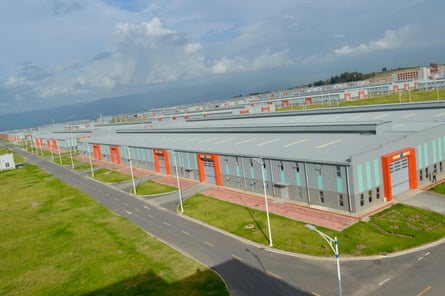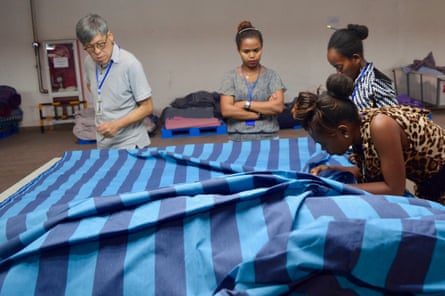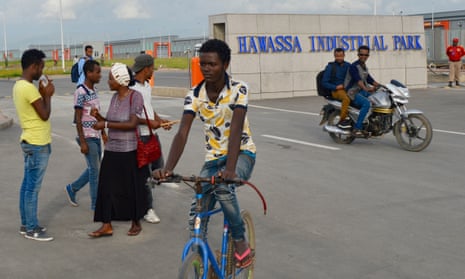Concentrating intensely, Haimanot Ayele picks up three pins from a pile and places them into a hole on a wooden board. He repeats the exercise for 90 seconds – a test of his dexterity.
The 23-year-old has travelled 56 miles to the city of Hawassa, in southern Ethiopia, to try out for a job in the textile business at the Chinese-built industrial park – a facility that should eventually cover 300 hectares (741 acres) – which was opened by the government in July 2016 to boost the economy and help it break free from aid.
The site in Hawassa is one of a number of similar facilities the authorities are building across Ethiopia. Manufacturers at Hawassa Industrial Park (HIP), situated on the outskirts of a city flanked by a picturesque Rift Valley lake, are supported with cheap electricity, free water and on-site administration services. Tax breaks are generous and rents are low, set at about $25 (£18.50) per square metre a year by the government, which compares with an average of $245 per square metre at auctions in Hawassa in 2015.
As wages in Asia rise, the strategy is to lure manufacturers seeking lower costs to one of the world’s least developed countries, which is still dominated by subsistence agriculture. Ethiopia’s government wants to create jobs for a growing population and generate hard currency from exports to invest in upgrading the economy. The schemes are also part of European migration policy: donors have pledged to mobilise $500m for two other industrial parks, as long as Ethiopia ensures that a third of the 90,000 jobs expected to be created go to refugees.
So far, the approach seems to be working in Hawassa, at least in terms of job creation. Since opening, HIP’s 52 units have already been leased out by 18 firms, including PVH, the US owner of brands such as Calvin Klein and Tommy Hilfiger. PVH suppliers occupy about a third of the other sheds at HIP. As well as profiting from cheap overheads and labour costs, PVH – whose $8.2bn turnover last year was close to Ethiopia’s projected 2017-18 tax revenue ($8.5bn) – will also benefit from duty-free access to US and European markets under deals for poorer nations.
The government, which has invested $250m in HIP, hopes 200,000 jobs a year will be created across the parks – a fifth of the estimated 1m jobs needed annually for Ethiopians entering the labour market. The government hopes HIP will create 60,000 jobs and $1bn in export revenues, which would account for about a third of Ethiopia’s current annual foreign earnings from goods.

But there are challenges. Of most concern are wages.
The main reason the government was drawn to Hawassa, a city of about 400,000 people, is evident from the eager potential recruits, like Haimanot, milling around the test centre. About 150 people a day from within a 60-mile radius of the city are tested for dexterity and coordination in the hope of getting a job at the plant.
Haimanot says he wants a change from being a motorbike driver. “Here, I want to get education and knowledge.” Wages and working conditions at the park vary. Foreign workers receive a five-year income-tax waiver and live in apartments with a lake and food court, but the same attention hasn’t been given to accommodation for Ethiopians.
Tsegaye Teferra, a cloth-cutter for Sri Lanka’s Hirdaramani garment company, receives a monthly salary of 650 birr (£17) for working eight hours a day, six days a week. The company, which didn’t respond to a request for comment, provides transport but not food or housing, he says. His rent is 600 birr, so he shares a room with a friend. He’s looking for better-paid work. “People come from the countryside for jobs, and then they start begging their families for money,” Tsegaye says.
Another worker sharing a 600-birr room is Mihret Gobeso, 18, who describes her workplace within HIP only as “Shed 37”. She works nine hours a day, six days a week for 850 birr a month. “The salary is not good,” Mihret says.
But wages are better than in some other professions in Ethiopia. An estimated 80% of Ethiopia’s jobs are found in the low-paid agriculture sector. Public sector jobs pay a minimum of 420 birr per month, while approximately 30% of the country’s then population of 90 million lived below the poverty line in 2011.
Manufacturers increasing wages at HIP seems unlikely, though, as the primary attraction of Ethiopia is the cheap labour: wages are roughly a quarter of those in China. And despite the huge profits expected in some cases, businesses are realising relocating is not as cheap as was hoped.
The Chinese company Wuxi Jinmou, which supplies the fabric for PVH clothes, has built a textile factory at HIP, investing $18m in state-of-the-art machinery.
But, says Peter Wan, who oversaw the construction of the factory, all cotton and spare parts have to be shipped in. The company is able to buy Ethiopian sodium hydroxide, but it’s expensive, so Wan is considering ordering from China. “Even with shipping costs, it might be worth it,” he says.
Transport is another troubling issue for exporting products. Companies have to pay up to $2,000 for a container from Hawassa to the port in Djibouti, about 600 miles away. That problem may ease once a planned railway is built to connect the park to an existing railway line that runs from the Ethiopian capital, Addis Ababa, to the port, but the government hasn’t yet secured financing. An additional stretch of motorway may also help and should reduce the risk of political protesters blocking the route, which has occurred several times since construction of HIP began. The current road runs through restive towns in the Oromia region.

On top of that is a concern about low productivity by employees unfamiliar with factory work. “The workers here are not hard working. And they are slow to learn,” Wan says. He says Wuxi pays a minimum of 1,100 birr per month. The recruits need training, but with inadequate housing and transport, he’s worried about a high turnover of staff as the rapidly rising cost of living eats into pay packets.
Given all this, it’s perhaps not surprising that Wuxi is concerned about the long-term profitability of its Ethiopian venture. “If living standards cannot be controlled by the government, within 10 years maybe we cannot earn enough money for our investment,” he says.
However, Stefan Dercon, a development economist from Oxford University who has conducted research on Ethiopia’s industrialisation, says all sides need to be realistic about the benefits the park can bring. “It’s going to be difficult to balance things, but it’s quite a step up from what we’ve seen before, and makes me quite optimistic,” he says.
By attracting a big player like PVH to Hawassa, the government has significantly improved the park’s chances of success, he says, as its presence will tempt others to commit. And if production lines do well, wages will rise.
“Let’s never romanticise the life of kids in rural areas in Ethiopia,” Dercon adds. “This is not going from a terrible life to a really good life … it’s going from a terrible life to a slightly better one.”
And while HIP will not make its workers rich, its success could be important for Ethiopia’s long-term economic trajectory. “Evidence suggests that if a country succeeds in light manufacturing, then there’s not a single example of a country that has then gone backwards,” he says.

Comments (…)
Sign in or create your Guardian account to join the discussion